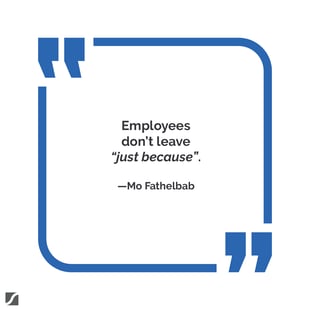Struggling With Employee Retention? These 5 Tips Can Help


A record-breaking 47.4 million people in the United States left their jobs in 2021.
This unprecedented number of employees who are jumping ship is a phenomenon that we’ve come to know as the Great Resignation. It’s adding another challenge to the already-complex process of building a successful business.
If you’re searching for ways to stave off the effects of the Great Resignation in the business you’re building, you’ve come to the right place.
Some of the top thought leaders in business development have shared with Growth Institute their insight about retaining top employees in today’s changing work environment. These thought leaders have discussed:
- Some key concerns behind the Great Resignation
- Steps you can take now to address those issues
Best-selling author Mo Fathelbab puts it succinctly. Employees, he says, don’t leave “just because.”

The reasons for employee dissatisfaction run the gamut, from a lack of meaningful relationships to a poorly designed compensation structure. Many of the concerns behind the exodus of employees also share something in common: They’re related to your company’s culture.
In this article, I’ll share some culture-driven ideas about protecting your organization during the Great Resignation, and I’ll include some of my own tips for business operations that boost employee satisfaction.
5 Employee Retention Problems And Solutions
Let’s look at 5 key employee retention concerns that are playing a role in the Great Resignation. Then let’s also uncover tips for changing your business culture to address each of them.

Problem: Lack Of Meaningful Relationships
Too often, Mo says, employees don’t feel connected with others on the job. But Mo—an expert on healthy business cultures whose forthcoming book is A Culture Of Belonging: The Antidote To The Great Resignation—says that meaningful relationships are a key indicator of staff longevity at an organization.
With remote work becoming a permanent fixture in many workplaces, the need to facilitate connections is more critical than ever.
Solution: Establishing Peer Groups
Peer groups can help employees develop a sense of belonging by encouraging vulnerability. And vulnerability leads to empathy, another important component of feeling connected.
You can establish peer groups for employees from underrepresented populations, as Google has. Or you can form peer groups designed to facilitate open discussion about a business’ culture, as U.S. company Pathstone did. Any commonality can help your staff establish respect for each other as peers and form long-term bonds with co-workers and the organization where they work.
Problem: Over-Abundance Of Stressors
Today’s employees are being bombarded by external stressors—from health concerns to news alerts—and many are bottling up the emotions those issues are causing. Mindfulness and meditation expert Oksana Esberard says employees often don’t recognize and share their concerns and feelings, instead simply dwelling on the negative feelings they’re internalizing.
Oksana, the author of the best-selling book Next Level You, notes that allowing emotions to fester is counterproductive. It allows them to interfere with attitudes about the workplace and decrease levels of productivity.
Solution: Recognizing Employees’ Challenges
You and your team should feel comfortable taking the time to respond to emotions, instead of bottling up feelings. Whether you’re taking 30 minutes to calm down or moving around to release stress hormones, it’s critical that your behavior fosters in an environment that encourages people to experience emotions.
Lead the way to healthy attitudes by accepting that employees have good and bad days. Check-in with yourself and others, gauge how things are going, and provide the space to take action in addressing emotions.
Problem: Ineffective Techniques For Communication
Business leaders often craft messages to share what they want to say, instead of what employees need to hear. Communicating in this way, Conor Neill says, focuses not on team members but on you—and often leaves the team frustrated because they don’t have the information they need to effectively do their jobs.
Conor, an authority on resilient leadership, says this apparent lack of caring among leadership then causes people to disengage.
Solution: Asking 4 Key Questions
Put yourself in your employees’ shoes by learning what issues they want the company to address. He suggests regularly talking with employees to ask them:
- What’s going well?
- What’s not going well?
- What needs to change?
- What else?
At first, you’ll likely get superficial answers. But as you make it a habit to ask these questions of employees, they’ll understand that you care. They’ll get comfortable opening up about what’s going on in their work.
Problem: Wrong Approach To Compensation
Scaling Up thought leader Verne Harnish says too many businesses give compensation the last thought. To make matters worse, corporate leaders often consider it to be a form of bribery. That thinking does little to encourage long-term increases in production or a commitment to the organization.
Solution: Following 5 Compensation Design Principles
Establishing the kind of compensation that attracts and retains the best employees calls for thinking of it as part of your organization’s culture. Verne recommends following these 5 design principles for culture-building compensation:
1. Be Different
Consider pay structures that will hit home with the employees you seek. The City Bin Co. in Ireland, for example, has touted the physical training employees can get as part of the job as perks for athletes.
2. Fairness, Not Sameness
Recognize that people perform at different levels for the same job. Then develop wide salary bands for each level of pay to reflect this fact.
3. Easy On The Carrots
Spot bonuses don’t encourage everyone to perform at their best, so establish compensation plans that reward the effort of the whole team. Swiss company Egon Zehnder, for example, offers a fixed salary that encourages long-term relationships with customers and employees, and it boasts a longer-tenured staff than nearly all the clients it serves.
4. Gamify Gains
Compensation structures that employees can treat as a game often are attractive. Australian company MiniMovers offers each employee a financial bonus when the entire staff avoids breaking the furniture they move.
5. Sharing Is Caring
Longer-term payouts can help employees avoid the tendency to think of bonuses as an entitlement, and they aid in retention. Stock vesting bonuses, for example, payout over time—if the employee is on staff to receive the payout.
Problem: Overload Of Ineffective Meetings
I also see a recurring problem that’s leading to dissatisfied employees: Calendars are overstuffed with meetings, many of which seem pointless to them.
These meetings often include people who don’t need to attend. They stretch to fill a predetermined time frame, even if the relevant discussion is completed well before that. Or they take the place of an email or 2.
Solution: Adopting A Meeting Rhythm
Meetings are mandatory, but that doesn’t mean they must be drudgery. Adopt a cadence for your regular meetings, with a set process for who will attend and what the discussion will entail:
- Daily huddles—10 to 15-minute meetings with larger groups first thing in the morning to set the day’s direction
- Weekly meetings—Hour or hour-and-a-half meetings for management to make plans and adjustments
- Monthly meetings—4-hour sessions, with corporate leaders spending 1 hour reviewing the past month, 1 hour solving a major problem, 1 hour tackling an opportunity, and 1-hour learning
Quarterly and annual meetings are lengthier sessions to address long-term issues.
Encourage participation from all who attend, and stick to the issue at hand. Additionally, it’s a good rule of thumb to set a meeting for any topic that requires more than 3 emails to resolve.
Rethink Your Employee Retention During The Great Resignation
Don’t let employee retention concerns interfere with your efforts to scale up your business. Safeguard yourself by focusing on:
- Strong relationships
- Stress relief
- Effective communication
- Creative compensation
- Productive meetings
If you’d like to learn more about putting these concepts into action, I invite you to check out resources featuring Mo, Oksana, Conor, Verne, and me:
- Micro-courses, podcasts, and implementation tools through Growth Institute’s The Edge
- Verne’s “Scaling Up: Compensation” webinar replay
- Mo’s Forum: The Secret Advantage Of Successful Leaders book
- Oksana’s Next Level You: How I Transformed My Life With Mindfulness And Meditation book
- Verne’s Scaling Up Compensation: 5 Design Principles For Turning Your Largest Expense Into A Strategic Advantage book


%2016.55.51.png)
